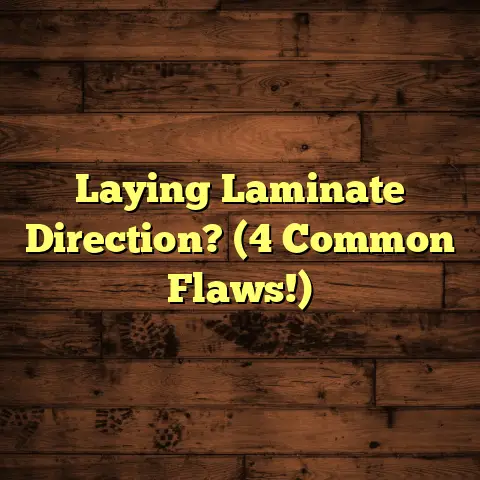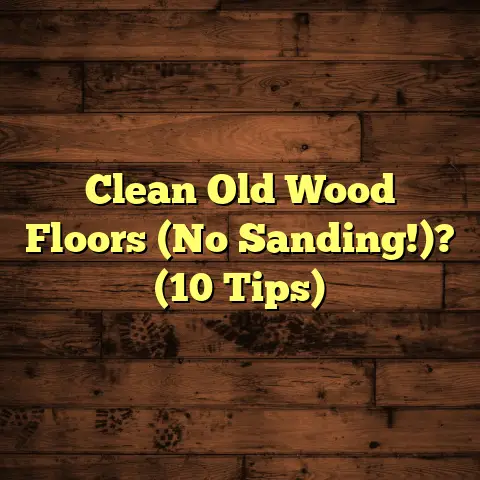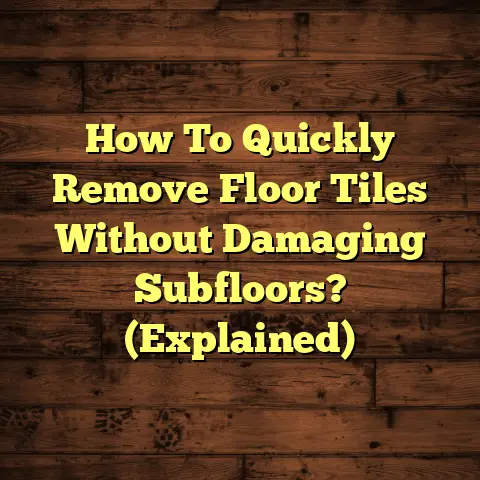Bleach on Tile Floors? (2 Warnings To Know!)
And let’s be honest, first impressions matter, right? When guests walk into your home, the floors are one of the first things they notice.
Tile floors, in particular, can really elevate the look of a space, creating a welcoming vibe for everyone.
Now, when it comes to cleaning, many of us reach for the big guns: bleach. It’s been a go-to for generations, thanks to its powerful disinfecting properties and ability to tackle tough stains.
But here’s the million-dollar question: Is using bleach on tile floors actually a good idea?
Well, that’s what we’re going to dive into today.
I want to share two crucial warnings you need to know before you reach for that bottle of bleach. Trust me, understanding these potential pitfalls can save you a lot of headaches (and money!) down the road.
The Appeal of Bleach as a Cleaning Agent
Let’s start by acknowledging why bleach is such a popular cleaner in the first place.
For decades, bleach has been a staple in households worldwide. Its effectiveness against bacteria, viruses, and mold is undeniable.
Think about it – we’ve been taught to use it for everything from sanitizing surfaces to whitening laundry.
There are primarily two types of bleach you’ll find on store shelves:
-
Chlorine Bleach: This is the most common type, known for its strong disinfecting power. It contains sodium hypochlorite and is highly effective at killing germs and removing stains.
-
Oxygen Bleach: This is a gentler alternative, often containing hydrogen peroxide or sodium percarbonate. It’s better for color-safe cleaning and less likely to damage certain surfaces.
When it comes to tile floors, bleach seems like a no-brainer. It can disinfect, remove stubborn stains, and even brighten dull tiles, making them look brand new.
I’ve heard countless stories from homeowners who swear by bleach for their tile floors.
One homeowner told me, “I had some really tough stains on my kitchen tile, and nothing seemed to work. Then I tried bleach, and it was like magic! The stains disappeared, and my floors looked sparkling clean.”
Another shared, “I use bleach regularly to disinfect my bathroom tile, especially around the toilet. It gives me peace of mind knowing that I’m killing germs and keeping my family healthy.”
But before you jump on the bleach bandwagon, let’s pump the brakes for a moment.
Warning #1 – Potential Damage to Tile and Grout
This is where my years of experience as a flooring contractor come in handy. While bleach can seem like a miracle worker, it’s crucial to understand its potential impact on your tile and grout.
Bleach, at its core, is a powerful chemical.
Chlorine bleach, in particular, contains sodium hypochlorite, which can react with various materials, including those found in tile and grout.
Over time, this reaction can weaken grout, leading to cracks and discoloration.
Think of grout as the glue that holds your tiles together. If that glue starts to break down, you’re looking at potential problems like loose tiles, water damage, and expensive repairs.
Now, not all tiles are created equal. Some types are more susceptible to bleach damage than others.
-
Ceramic Tiles: Generally more resistant to bleach, but prolonged exposure can still affect the glaze and cause fading.
-
Porcelain Tiles: More durable than ceramic, but certain types with special finishes can still be damaged.
-
Natural Stone Tiles (e.g., Marble, Limestone): These are highly porous and can be severely damaged by bleach. Avoid using bleach on natural stone tiles at all costs!
How do you know if bleach is damaging your tile floors? Keep an eye out for these signs:
-
Grout Discoloration: The grout starts to turn yellow, white, or even crumble.
-
Fading Tile Colors: The colors of your tiles appear dull or washed out.
-
Cracked or Crumbling Grout: Visible cracks or pieces of grout missing.
-
Loose Tiles: Tiles that feel wobbly or come loose from the floor.
I’ve seen firsthand the damage bleach can cause.
One client called me in a panic because her white grout had turned yellow after she used bleach to clean her kitchen floor. The discoloration was so severe that she had to have the entire grout replaced, costing her hundreds of dollars.
Another client used bleach on her natural stone bathroom tiles, and the result was disastrous. The bleach etched the surface of the stone, leaving permanent stains and a dull, uneven finish.
Warning #2 – Health Risks Associated with Bleach Use
Beyond the potential damage to your floors, it’s essential to consider the health risks associated with using bleach.
Bleach can be harmful to your health if not used properly.
It can cause respiratory issues, skin irritations, and allergic reactions in some people.
When you inhale bleach fumes, it can irritate your lungs and cause coughing, wheezing, and shortness of breath. People with asthma or other respiratory conditions are particularly vulnerable.
Bleach can also irritate your skin, causing redness, itching, and even burns. It’s essential to wear gloves when handling bleach and to avoid getting it on your skin.
Some people may also have allergic reactions to bleach, leading to symptoms like hives, swelling, and difficulty breathing.
To minimize these risks, it’s crucial to use bleach in a well-ventilated area. Open windows and doors to allow fresh air to circulate.
Always wear personal protective equipment (PPE) when handling bleach, including gloves, eye protection, and a mask.
And here’s a critical warning: Never, ever mix bleach with other household cleaners, especially ammonia.
Mixing bleach with ammonia can create toxic gases that can be deadly.
According to the CDC, mixing bleach with ammonia produces chloramine gas, which can cause:
- Coughing
- Shortness of breath
- Chest pain
- Pneumonia
- Fluid in the lungs
- Death
Mixing bleach with other cleaners can also create harmful gases. For example, mixing bleach with acid-based cleaners can produce chlorine gas, which is also toxic.
The CDC reports that thousands of people are treated in emergency rooms each year for bleach-related injuries.
A study published in the American Journal of Emergency Medicine found that household cleaning products, including bleach, were responsible for a significant number of unintentional chemical exposures.
Alternative Cleaning Solutions for Tile Floors
Okay, so we’ve established that bleach isn’t always the best option for cleaning tile floors. But what are the alternatives?
Well, there are many eco-friendly and non-toxic cleaning solutions that can effectively clean and disinfect your tile floors without the risks associated with bleach.
One popular option is steam cleaning.
Steam cleaners use hot steam to loosen dirt and grime, killing bacteria and viruses without the need for harsh chemicals.
Steam cleaning is effective on tile and grout, and it’s safe for most types of tile.
Another great alternative is vinegar. Vinegar is a natural disinfectant and deodorizer.
Mix equal parts white vinegar and water in a spray bottle, spray it on your tile floors, let it sit for a few minutes, and then wipe it clean.
Baking soda is another excellent cleaning agent.
It’s a mild abrasive that can help remove stubborn stains and grime. Make a paste of baking soda and water, apply it to the stained area, let it sit for a few minutes, and then scrub it clean.
Conclusion
So, there you have it – the good, the bad, and the alternatives when it comes to using bleach on tile floors.
We’ve explored the appeal of bleach as a cleaning agent, but we’ve also uncovered the potential damage it can cause to your tile and grout, as well as the health risks associated with its use.
Ultimately, the decision of whether or not to use bleach on your tile floors is up to you.
But I urge you to weigh the risks and benefits carefully. Consider the type of tile you have, the potential for damage, and the health implications.
There are many safe and effective alternatives to bleach that can help you keep your tile floors clean and beautiful.
Remember, maintaining a beautiful home shouldn’t come at the expense of your health or the integrity of your flooring.
Make informed decisions, choose wisely, and enjoy your sparkling clean tile floors!
Disclaimer: This article is for informational purposes only and should not be considered professional advice. Always consult with a qualified flooring contractor or cleaning expert before making any decisions about cleaning or maintaining your tile floors.





